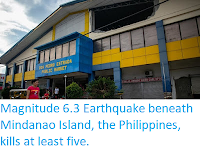At least thirteen people have died after Typhoon Kamuri swept across the Philippines on Monday 2-Tuesday 3 December 2019. The storm, known in the Philippines as Typhoon Tisoy, first made landfall in Sorsogon Province on Luzon Island at about 11.00 pm on Monday 2 December, as a Category 4 Typhoon (a storm with sustained winds of between 209 and 251 kilometres per hour), sweeping across Luzon island over the next few hours, then heading out to sea. It made landfall again on Burias Island at about 4.00 am, before continuing to move westward, eventually making landfall for a third time on Marinduque Island at about 8.30 am, then Mindoro Island at about 12.30 pm on Tuesday 3 December. The majority of the fatalities are thought to have occurred on Luzon Island, where at least three people drowned, on person was electrocuted, and several more were crushed by falling trees and other objects.
Damage caused by Typhoon Kammuri in Legazpi City in Albay Province, on southern Luzon Island. Reuters.
Tropical storms are caused by the warming effect of the Sun over
tropical seas. As the air warms it expands, causing a drop in air
pressure, and rises, causing air from outside the area to rush in to
replace it. If this happens over a sufficiently wide area then the
inrushing winds will be affected by centrifugal forces caused by the
Earth's rotation (the Coriolis effect). This means that winds will be
deflected clockwise in the northern hemisphere and anti-clockwise in the
southern hemisphere, eventually creating a large, rotating Tropical
Storm. They have different names in different parts of the world, with
those in the northwest Pacific being referred to as typhoons.
The path and strength of Typhoon Kammuri. Thick line indicates the
past path of the storm (till 6.00 am GMT on Thursday 5 December 2019), while the thin line indicates the predicted future path of the storm,
and the dotted circles the margin of error at twelve and twenty four, and thirty six hours ahead. Colour indicated the severity of the storm. Tropical Storm Risk.
Despite the obvious danger of winds of this speed, which can physically
blow people, and other large objects, away as well as damaging buildings
and uprooting trees, the real danger from these storms comes from the
flooding they bring. Each drop millibar drop in air-pressure leads to an
approximate 1 cm rise in sea level, with big tropical storms capable of
causing a storm surge of several meters. This is always accompanied by
heavy rainfall, since warm air over the ocean leads to evaporation of
sea water, which is then carried with the storm. These combined often
lead to catastrophic flooding in areas hit by tropical storms.
See also...








